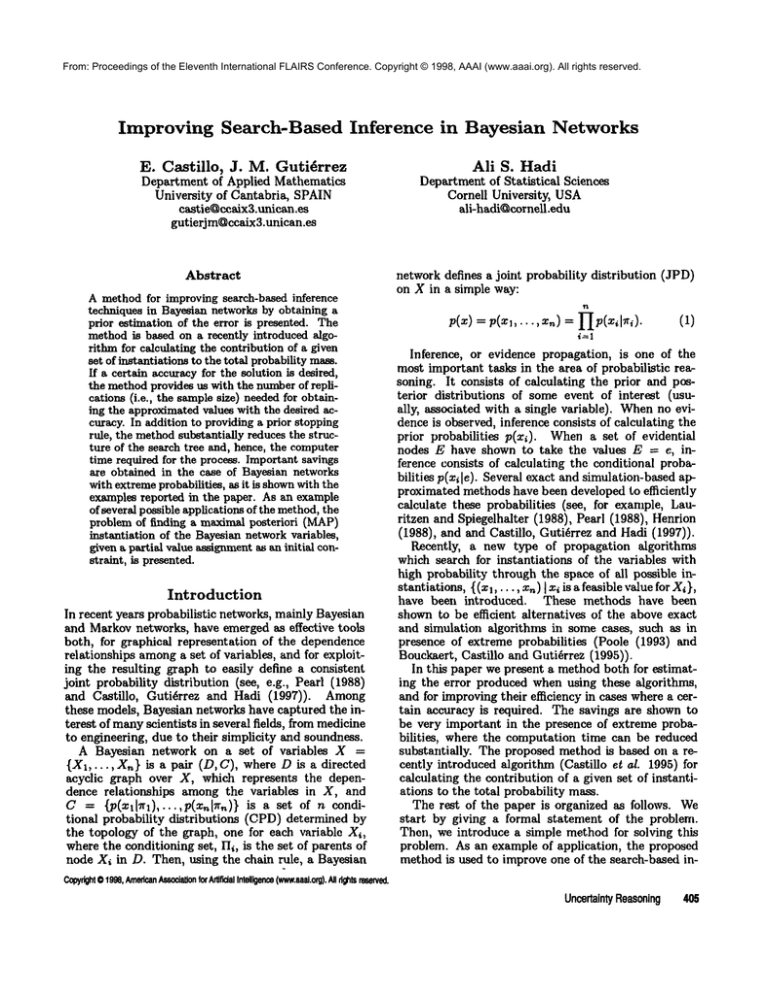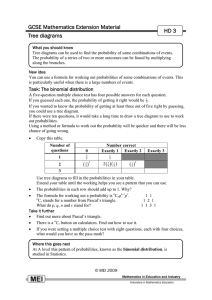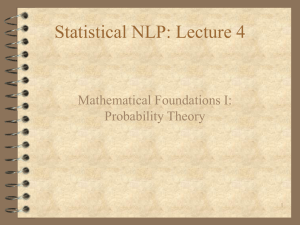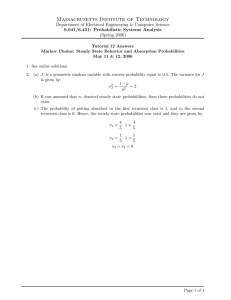
From: Proceedings of the Eleventh International FLAIRS Conference. Copyright © 1998, AAAI (www.aaai.org). All rights reserved.
Improving
Search-Based
Inference
E. Castillo,
J. M. Guti~rrez
Department of Applied Mathematics
University of Cantabria, SPAIN
castie~ccaix3.unican.es
gutierjm@ccaix3.unican.es
Abstract
A methodfor improvingsearch-basedinference
techniquesin Bayesiannetworksby obtaining a
prior estimation of the error is presented. The
methodis based on a recently introducedalgorithmfor calculating the contributionof a given
set of instantiationsto the total probabilitymass.
If a certain accuracyfor the solutionis desired,
the methodprovidesus with the numberof replications (i.e., the samplesize) neededfor obtaining the approximated
valueswith the desired accuracy. In additionto providinga prior stopping
rule, the methodsubstantially reducesthe structure of the search tree and, hence, the computer
time required for the process. Importantsavings
are obtained in the case of Bayesiannetworks
withextremeprobabilities,as it is shown
with the
examplesreported in the paper. As an example
of severalpossibleapplicationsof the method,the
problemof finding a maximalposteriori (MAP)
instantiation of the Bayesiannetworkvariables,
givena partial valueassignment
as an initial constraint, is presented.
in Bayesian
Networks
Ali S. Hadi
Departmentof Statistical Sciences
Cornell University, USA
ali-hadi@corneU.edu
networkdefines a joint probability distribution (JPD)
on X in a simple way:
n
=
(1)
=
i--=l
Inference, or evidence propagation, is one of the
mostimportant tasks in the area of probabilistic reasoning. It consists of calculating the prior and posterior distributions of someevent of interest (usually, associated with a single variable). Whenno evidenceis observed,inference consists of calculating the
prior probabilities p(x~). Whena set of evidential
nodes E have shownto take the values E = e., inference consists of calculating the conditional probabilities p(x~ [e). Severalexact andsimulation-basedapproximatedmethodshave been developedto efficiently
calculate these probabilities (see, for example, Lauritzen and Spiegelhalter (1988), Pearl (1988), Henrion
(1988), and and Castillo, Guti~rrez and Hadi (1997)).
Recently, a new type of propagation algorithms
whichsearch for instantiations of the variables with
high probability through the space of all possible instantiations,{(xl, ¯ ¯., x~)I x~is a feasiblevaluefor Xi},
Introduction
have been introduced. These methods have been
In recent years probabilistic networks,mainlyBayesian
shownto be efficient alternatives of the above exact
and Markovnetworks, have emergedas effective tools
and simulation algorithms in somecases, such as in
both, for graphical representation of the dependence
presence of extreme probabilities (Poole (1993)
relationships amonga set of variables, and for exploitBouckaert,Castillo and Guti6rrez (1995)).
ing the resulting graph to easily define a consistent
In this paper wepresent a methodboth for estimatjoint probability distribution (see, e.g., Pearl (1988)
ing the error producedwhenusing these algorithms,
and Castillo, Guti6rrez and Hadi (1997)). Among
and for improvingtheir efficiency in cases wherea certhese models, Bayesian networkshave captured the intain accuracy is required. The savings are shownto
terest of manyscientists in several fields, frommedicine
be very important in the presence of extreme probato engineering, due to their simplicity and soundness.
bilities, where the computation time can be reduced
substantially. The proposed methodis based on a reA Bayesian network on a set of variables X -cently introduced algorithm (Castillo et al. 1995) for
{X1,..., X,,} is a pair (D, C), whereD is a directed
acyclic graph over X, which represents the depencalculating the contribution of a given set of instantiations to the total probability mass.
dence relationships amongthe variables in X, and
C = {p(xt[Irl),...,p(x~[Tr~)}
is a set of n condiThe rest of the paper is organized as follows. We
start by giving a formal statement of the problem.
tional probability distributions (CPD)determined
Then, weintroduce a simple methodfor solving this
the topology of the graph, one for each ~riable X~,
wherethe conditioningset, II~, is the set of parents of
problem. As an exampleof application, the proposed
node X~in D. Then, using the chain rule, a Bayesian
methodis used to improveone of the search-based inCopyright
¯ 1900,
American
Association
forAdifcial
Intelligence
(www.aaai.org).
Allrights
reserved.
Uncertainty
Reasoning
405
ference methods. Finall); we analyze tile MAPproblem comparing both the standard and the irnproved
search algorithms.
Statement of the Problem
p( x).
z:rCx)<q
: < q}l
’
IIxl
0.4
0.2
0
0.001
0.002 0.003 0.004 0.005
Figure 1: Distributions f(q) and s(q) for a ten-node
Bayesian network with probabilities taken from (0: 1).
The Proposed Method
(3)
where Ix is the set of all possible instantiations x =
(xl,..., x,~) of the variables in the set X and IAI stands
for the cardinal of the set A. Thus, for a given value q,
f(q) gives the ratio of instantiations with probability
lower than q and s(q) gives the contribution of all these
instantiations to the total probability mass.
Figure 1 shows both f(q) and s(q), for a ten-node
Bayesian network with random probabilities
taken
from (0, 1). This figure shows, for example, that 80%
of the instantiations contribute only 16%to the total
probability mass. In Bayesian networks with extreme
probabilities the contribution is muchsmaller. For example for a ten-node Bayesian network with random
extreme probabilities taken from (0, 0.1) (J (0.9, 1)
found that 85%of the instantiations
contribute less
than 0.02% to the total probability mass. Therefore,
it is possible to obtain substantial savings in the computation time by paying only a small error. Moreover,
the more extreme the probabilities, the smaller the error produced.
The main problem for implementing the method
consists of estimating the left tail of s(q) in an efficient way. This tail contains the instantiations that
contribute the least to the total probability. Since. we
need to estimate not the central part, but the left tail
of the distribution, we need to use extreme value theory (see Castillo (1988) for a general introduction
extreme value theory).
406 Castillo
0.8
(2)
Weare also interested in calculating the ratio of
the number of instantiations
x included in the set
(x : p(x) < q} to the total number of instantiations,
since these are the instantiations we carl skip in the inference process by paying a total error s(q). This ratio
is defined by
f(q)
f(q)
,
0.6
A natural way of approximating marginal, or conditional, probabilities consists of summingonly on the
(small) set of instantiations I, which includes all instantiations with associated probability larger than a
given value q. Then, the total error produced is given
by ~’~x~zp(x) = ~-~-x:~(z)<q p(x). Thus, for estimating
error bounds, we need to determine the contribution
of all instantiations with probability lower than q to
the total probability mass. To do this, we consider the
error fimction
s(q)=
1-
Castillo et aL (1995) show that the function s(q)
the Lorenz curve of p, which is a CDFthat can be associated with a new random variable q with the sarne
domain as p. Given a threshold value u, they showed
that the distribution s(q), for q < u, carl be approximated by the product of a function s(u) and the CDF
of q - u, g(q - u), in the following way:
s(q) = s(u)g(q
(4)
Since it is the left tail of a distribution, g(q - u) can
be approximated by the Reversed Generalized Pareto
Distribution (RGPD)when u is reasonably small. The
RGPDU(z;6, ta), introduced by Pickands (1975),
defined by
1
=
;
1+->0, (5)
a
where tr and t~ are the scale and shape parameters,
respectively.
Then, given a threshold value u, the proposed model
for the left tail of s(q) is
s(q) = s( )U(q - o);
(6)
which depends on s(u) and two parameters, a and a,
for each threshold value u.
The problem for estimating s(u) and U(q -u, ~, a)
is that the associated randomvariable q is not directly
observable. However, we can observe p and obtain an
ordered sample (pl,...,
Pro) from p(x). Then, a natural e.utimator for s(u) based on this sample is
.~(u) I{P, : P,< u}l
m
(7)
There is a vast literature on estimating the parameters 6 and a for a RGPD(see Castillo and Hadi (1994),
and the references therein). Any of these methods can
be used to estimate the parameters. For illustrative
purpose, we use here the conceptually simple method
of moments (MOM)estimates
are given by
&=~ ~-~-1,
0-----
3 ~-+1
,
where ¯ and s 2 are the sample mean and the sample
variance, respectively.
Given a sample size m and a threshold value for
the accumulated probability
e (the maximumerror
bound), we can estimate s(q) using (6) for those values
of the function lower than e. The threshold value u for
the probabilities for the left tail of the distribution is
chosen to be the me-th lower probability in the sample.
In this way the values s(q) lower than e will correspond
toq <u.
Wehave performed several experiments to analyze
the quality of the estimation given by this method.
For example, Figure 2(a) shows the exact value of 8(q)
together with its approximation ~(q) for a 20-node
network with probability tables selected from (0, 1).
The sample size taken to obtain this estimation is
= 10000 and e -- 0.05. Figure 2(b) corresponds
to a 20-node network with extreme probabilities taken
from (0,0.1) U (0.9, 1). in both cases, the value u
tained by considering the 500-th lower probability in
the sample, corresponding to the threshold error value
s(u)= ~ = 0.05.
o.os
.-_.......~-=...... F"............. T~::~
:
.................
................
................
[
:(a)
Improving Search-Based Inference
of the parameters which
!
.
~
o.o,÷
..............
i...................
!..............
The algorithm introduced in the previous section can
be applied to estimate the error produced when approximating the probabilities of an event using one
of the existing deterministic approximation methods.
On the one hand, the deterministic stratified method
(see Boucksert et al. (1995)) works by dividing
sample space into several regions and then choosing
an optimum number of instantiations
from each region. In this way, rare instantiations can be avoided.
A sample of size ra obtained with this algorithm will
contain all the instantiatious with probabilities larger
than I Therefore, the error estimation method can
be used to calculate the number of replications needed
to obtain an approximation with any desired accuracy. For example, if we wish to obtain an approximation of the probabilities of any event in the above
Bayesian network associated with Figure 2(b), with
error lower than 0.02, then the estimation of the left
tail of the distribution shownin this figure would allow us to obtain the necessary numberof replications,
s.
n < 1/(3.6 x 10-s) < l0
On the other hand, search-based propagation methods work by creating a search tree whose branches are
associated with partial instantiations of the variables.
In every iteration step, the search process chooses one
of the branches of the tree associated with an instantiation (z~,... , ~k)" If the associated instantiation is
complete, that is, if k = n, then the branch is pruned
from the tree and the instantiation is included in the
sample. Otherwise, the tree is augmented with as
many new branches as values of the next variable,
xk+l. Thus, the original branch, (x~,...,x~),
is replaced by the branches (x~,..., z~, xk+l) for all possible values of Xk+1. Several search methods have been
proposed in the literature (see, for example, Henrion
(1991), Poole (1993), and Santos and Shimony(1994)).
The main difference amongthem is the selected criterion for choosing the branches in each iteration step. In
the next two sections we describe one of these methods
and introduce a modified algorithm based on the error
estimation method presented in Section. However, the
same ideas can be applied to improve the efficiency of
any other search method.
.......
.......................
,..............................
_
?"i
..............................................................
--:
0 _’..~.~..~..La-.~..L.A--__.~.~.,,.
’ ’ .L.~..,.~.--..L..~--L~..:.
"6
0
:].4 10-/ 6.8 10.7 1.02 10"6 "~
1.36 10
|.7 10
q
0.05
_.
...............
- (b)
0,04..................
~.,
~~_:
~ ...............................
_
’ .................
’~.o.o3-.............
~.
Maximum Probability
Search
Algorithm
The algorithm of maximumprobability search (Poole
(1993)) uses the criterion of maximumprobability
to choose the branches in every iteration step. In
this case, besides providing a stopping criteria, the
above error estimation method reduces substantially
the computational complexity of this algorithm since
branches with lower probabilities than the threshold
value can be pruned from the search tree.
The maximumprobability criterion for choosing the
branches used in this algorithm makes it suitable for
solving the MAPproblem, since it obtains the instantiation with highest probability in each step of the pro-
- ..........
II..............
-:
ii................
i...............
:
i
0.01
!
0
0
[
!
~
:
3.6 10"s 7.2 10"~ 1.08 104 1.44 10"4 ~
1.8 10
q
Figure 2: Error estimation for a 20-node (a) non extreme and (b) extreme Bayesian network with m
10000and e --- 0.05.
UncertaintyReasoning
407
cess. Thus, this algorithm combines both inference and
abductive inference in an intuitive way.
If a given accuracy e is required for the solution,
then the structure of the search tree carl be reduced
by skipping those instantiations in the left tail of the
distribution that contribute less than e to the total
probability mass. Although the probability associated
with this set is very low, it carl contain a large number
of instantiations. This modification leads to important
reductions in both, the structure of the tree and the
computation time.
Weperform some experiments to evaluate the performance of the modified maximumprobability search
algorithm as compared to the performa~me of the
standard algorithm. A Ba)~sian network consisting
of ten binary variables is randomly generated. In
the first experiment, the random numbers associated
with the CPDs are selected from the unit interval
and in the second experiment the numbers are uniformly selected from [0,0.1] U [0.9, 1] to obtain a JPD
with extreme probabilities.
The experiments are performed by running the algorithms with values of the
minimal accumulated probability 6 from the values
{0.8, 0.9, 0.95, 0.975, 0.99}. The performance is measured by (a) the number of complete generated instantiations, (b) the maximumsize of the queue, and (c)
the time to execute the approximation.
Figure 3 shows the results for the case where the
probability tables are selected from the unit interval.
Figure 4 showsthe results for the case of Bayesian networks with extreme probabilities chosen in the interval
[0, 0.1] U [0.9, 1]. As could be expected, the execution
time and the maximumsize of the queue rises when
the accumulated probability rises. Note that the number of instantiations for a given accumulated probability is the same for the standard and modified algorithms. WhenFigures 3 and 4 are compared, one sees
that all measured criteria are larger for the distributions that have their probabilities from the unit interval, confirming that the maximumprobability search
method works better for cases where extreme probabilities are involved (see Poole (1993)). This is caused
by the large size of the largest intervals that appear
when distributions contain extreme probabilities.
Figures 3 and 4 show that the modified algorithm
produces important savings both in the computation
time and in the complexity of the search tree (the maximumnumber of instantiations
in the queue) as compared with the standard method. These figures also
show that the savings increase when extreme probabilities are involved.
The MAP Problem
In thissection
we analyze
theproblem
of finding
a maximalposteriori
(MAP)instantiation
of theBayesian
networkvariables.
Severalexactand approximate
methods
havebeenproposed
in theliterature
forthis
task(seeShimony
(1994)andthereferences
therein).
408 CasSio
600
’
I
....
I
....
Standard
500--
I
....
-
300--
200-0:
....
-
~
¯
D Siz~of queue ¯ Siz~of queuel
¯ ~. CPUtime
X CPU time
[
Oh~stantiations
I
4o0--:
100--
I
Modified I
e
= I
I
....
0.8
, , = , I ,
0.85
, . ¯ i
0.9
:
. . .
, :
0.95
1
Figure 3: A scatter plot of three perfi)rmance measures
versus 6 for the cases in which probability tables are
chosen from (0: l).
140
120-100-80:
60~
40:
20--
,i,o,.i,,..i,
’
Standard
’
’ I
Modified
t Size of queue ¯ Size of queue
X CPU time
+ CPU time
~’ Instantiations
" " " ~.
..
@
.7--
¯
0
+:
0---"
-I-II ..~.
+
I
+
+
I
0.8
.
0.85
,
,
I I
g
~
, , ,
0.9
X
, I , ,
×
."2-
= ,
0.95
Figure 4: A scatter plot of three performance measures
versus 6 for the cases in which probability tables are
ch(xsen from (0,0.1) U (0.9,
As we already mentioned, tile maximumprobat)ility
search algorithm provides an intuitive and elficient
method for finding the first m instantiations in the
network with highest probabilities. If we are only interested in the most probable explanation, then we can
run the methoduntil the first branch in the tree is completed.
To improve the efficiency of this method, we are interested in obtaining an estimation of the probability u
associated with the (m + l)-th instantiation with highest probability, since we can skip all the instantiations
with lower probability in the search process. The reduction of the complexity of the search tree will be very
important, since we are neglecting not only the left tail
of the distribution, but also most of the instantiations.
Thus, in this ease we are interested in estimating f(q).
Following the ideas used in Section we cart obtain a
uniform sample {Pl,.-.,P~} and take the (m + 1)-th
value with highest probability as a natural estimation
of u.
Figure 5 compares both the standard and the
modified algorithms by using a randomly generated
Bayesian network consisting of twenty binary variables
with the CPDsselected from the unit interval. The experiments are performed by running the algorithms to
find the rn most probable instantiations for different
values of rn. The performance is measured by (a) the
maximumsize of the queue and (b) the time to execute the approximation. It can be shown that both the
structure and the computation time are substantially
reduced in the modified algorithm.
1200 .
’
1000--"
I
....
¯ Size of queue
400--
’
" I
’
’
"
’
I
Sizeof queue]
=
x C~tim~
I
~-
+
x=
200 --
:1t
0
’
+
-..1-
= I
’
Modified [
+ cI, u time
800----"
¯
600 ~ ¯
0
I
Standard
tt
I
I
I
I
5
¯
.
,
,
I
10
m
¯
.
.
,
I
,
,
15
.
¯
I
-
20
Figure 5: A scatter plot of two performance measures
versus m for the MPAproblem.
Summaryand Conclusions
A method for improving search based inference procedures in Bayesian networks is presented. The method
consists of determining a threshold value for the probabilities associated with the instantiations, below which
they can be ignored without influencing the required
error for the estimates. A reversed generalized Pareto
distribution is used to estimate the tall of the distribution of the instantiation probabilities, combinedwith
MOM
estimates of its parameters. To this end a sample is simulated and its tail values used for the estimation. Once the tail is known, the desired percentiles
are obtained and used as threshold values. Several
examples of Bayesian networks are used to illustrate
the method. In particular Bayesian networks with associated extreme conditional probabilities are shown
to lead to substantial savings in both the required
memory (to store the search tree) and the computation time. The method is able to improve several well
known techniques such as the MAPproblem.
Acknowledgments
This work is partially supported by the University
of Cantabria, the Direcci6n General de Investigaci6n
Cientffica y T~cnica (DGICYT)(project TIC96-0580),
Iberdrola, and NATOResearch Office.
References
Bouckaert, R,. R., Castillo, E. and Guti~rrez, J. M.
(1995), "A Modified Simulation Scheme for Inference in Bayesian Networks," International Journal
of Approximate Reasoning, Voi. 20, 1-26.
Castillo, E. (1988), Extreme Value theory in Engineering, Academic Press, NewYork.
Castillo,
E. and Hadi, A. S. (1994), "Parameter
and Quantile estimation for the generalized extreme
value distribution," Environmetries, 5, 417-432.
Castillo, E., Bouckaert, R. R., Sarabia, J. M., and
Solares, C. (1995), "Error Estimation in Approximate Bayesian Belief Network inference," in Uncertainty in Artificial Intelligence 11, (P. Besnard and
S. Hanks, Fxis.), North Holland, Amsterdam,55--62.
Castillo, E., Guti6rrez, J. M., and Hadi, A. S. (1997),
Expert Systems and Probabilistic Network Models,
Springer-Verlag, NewYork.
Henrion, M. (1988), "Propagating Uncertainty
Bayesian Networks by Probabilistic
Logic Sampling," in Uncertainty in Artificial Intelligence ~,
(J.F. Lemmerand L. N. Kanal, Eds.), North Holland, Amsterdaxn, 317-324.
Henrion, M. (1991), "Search-Based Methods
BoundDiagnostic Probabilities in Very Large Belief
Nets," in Proceedings of the Seventh Conference on
Uncertainty in Artificial Intelligence. MorganKaufmann Publishers, San Mateo, CA, 142-150.
Lauritzen, S. L. and Spiegelhalter, D. J. (1988), "Local Computations with Probabilities
on Graphical
Structures and Their Application to Expert Systems," Journal of the Royal Statistical Society (B),
50, 157-224.
Pearl, J. (1988), Probabilistic Reasoningin Intelligent
Systems: Networks of Plausible Inference, Morgan
Kanfmann, San Mateo, CA.
Piekands III, J. (1975), "Statistical Inference Using
ExtremeOrder Statistics." The Annals of Statistics,
75:1,119-131.
Poole, D. (1993), "Average-case Analysis of a Search
Algorithm for Estimating Prior and Posterior Probabilities in Bayesian Networks with Extreme Probabilities," in Proceedings of the I3th International
Joint Conference on Artificial Intelligence, 13, 1,
606-612.
Santos, E., and ShimonyS. E. (1994), "Belief Updating by Enumerating High-Probability IndependenceBased Assignments," in Proceedings of the Tenth
Conferenceon Uncertainty in Artificial Intelligence,
506-513. Morgan Kaufmann Publishers, San Francisco.
Shimony, S. E. (1994), "Cost-Based Abduction and
MAPExplanation," Artificial Intelligence, 66, 345374.
UncertaintyReasoning
409








